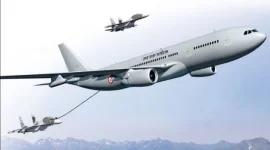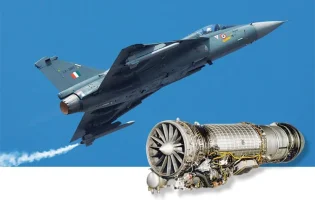- Views: 2K
- Replies: 20
India's pursuit of self-reliance in critical jet engine technology is set to take a major leap forward. The Gas Turbine Research Establishment (GTRE), a premier laboratory of the DRDO, has formally requested an Ilyushin IL-76 transport aircraft from the Indian Air Force (IAF) to serve as a dedicated flying test bed.
This move is aimed at accelerating the development of the indigenous Kaveri engine and the future power plant for the nation's ambitious Advanced Medium Combat Aircraft (AMCA).
The Ministry of Defence has engaged with the IAF to secure an older IL-76, a robust four-engine strategic airlifter, for this crucial national project. Establishing a domestic aerial testing platform is essential to breaking India's reliance on foreign facilities.
Currently, India depends on Russia’s Gromov Flight Research Institute for in-flight engine trials, a process that involves replacing one of the IL-76's native engines with the engine under development.
However, securing a slot at the Russian facility often involves a waiting period of nine to ten months, causing significant delays to development timelines.
The Kaveri engine program, first launched in the 1980s to power the Light Combat Aircraft (LCA) Tejas, has navigated a complex journey marked by technical hurdles and international sanctions. Despite these challenges, the program has been revitalised.
A non-afterburning variant, known as the Kaveri Derivative Engine (KDE), which produces around 50 kilonewtons (kN) of dry thrust, is scheduled for its first flight trials in 2025.
This engine is slated to power advanced unmanned platforms like the Ghatak combat drone. The knowledge and technology gained from this project are considered vital for the development of a 110 kN thrust class engine required for the AMCA, India's fifth-generation stealth fighter.
By creating its own flying test bed, India aims to streamline the entire engine validation process. Having a dedicated aircraft would significantly cut down on development time, reduce costs, and provide GTRE with greater autonomy over the testing cycle.
The IL-76, known as the 'Gajraj' in IAF service, is considered an ideal platform for this role due to its power, size, and ability to operate safely with different engine configurations, allowing engineers to gather critical performance data in real-world flight conditions.
Sources indicate that the Indian Air Force is expected to approve the proposal in the near future, aligning with the government's overarching 'Aatmanirbhar Bharat' (self-reliant India) policy in the defence sector.
This initiative is seen as strategically vital, particularly as regional security challenges grow with neighbouring countries advancing their own aerial combat capabilities. The establishment of an indigenous test bed signals a strong commitment from the defence ecosystem to achieve sovereignty in aerospace technology.
Nevertheless, significant challenges persist. The Kaveri program has historically struggled with developing advanced materials and achieving the high-thrust performance required for modern fighter aircraft.
Experts, including retired IAF Group Captain Ajay Ahlawat, have stressed the need for a next-generation "Kaveri 2.0" engine capable of producing over 100 kN of thrust to meet the demands of the AMCA and the Tejas Mk2.
The creation of an in-house flying test bed is a crucial step to rigorously test, refine, and validate new designs, potentially bridging these technological gaps and paving the way for a new era in Indian military aviation.





